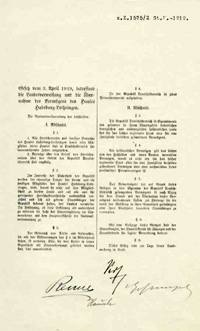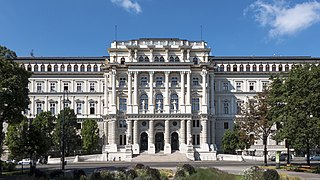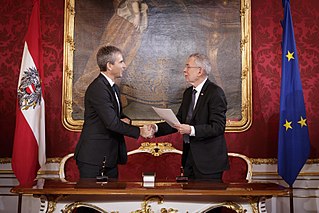
The chancellor of the Republic of Austria is the head of government of the Republic of Austria. The position corresponds to that of Prime Minister in several other parliamentary democracies.
A presidency is an administration or the executive, the collective administrative and governmental entity that exists around an office of president of a state or nation. Although often the executive branch of government, and often personified by a single elected person who holds the office of "president", in practice, the presidency includes a much larger collective of people, such as chiefs of staff, advisers and other bureaucrats. Although often led by a single person, presidencies can also be of a collective nature, such as the presidency of the European Union is held on a rotating basis by the various national governments of the member states. Alternatively, the term presidency can also be applied to the governing authority of some churches, and may even refer to the holder of a non-governmental office of president in a corporation, business, charity, university, etc. or the institutional arrangement around them. For example, "the presidency of the Red Cross refused to support his idea." Rules and support to discourage vicarious liability leading to unnecessary pressure and the early termination of term have not been clarified. These may not be as yet supported by state let initiatives. Contributory liability and fraud may be the two most common ways to become removed from term of office and/or to prevent re-election.

The president of Austria is the head of state of the Republic of Austria. Though theoretically entrusted with great power by the Constitution, in practice the president is largely a ceremonial and symbolic figurehead.

The Constitution of the Republic of Lithuania defines the legal foundation for all laws passed in the Republic of Lithuania. The first constitution of the contemporary republic was enacted on 1 August 1922. The current constitution was adopted in a referendum on 25 October 1992.

The Constitution of Austria is the body of all constitutional law of the Republic of Austria on the federal level. It is split up over many different acts. Its centerpiece is the Federal Constitutional Law (Bundes-Verfassungsgesetz) (B-VG), which includes the most important federal constitutional provisions.

A district is a second-level division of the executive arm of the Austrian government. District offices are the primary point of contact between residents and the state for most acts of government that exceed municipal purview: marriage licenses, driver licenses, passports, assembly permits, hunting permits, or dealings with public health officers for example all involve interaction with the district administrative authority.

The Government of Austria is the executive cabinet of the Republic of Austria. It consists of the chancellor, who is the head of government, the vice chancellor and the ministers.

The Habsburg Law was a law originally passed by the Constitutional Assembly of the Republic of German-Austria, one of the successor states of dissolved Austria-Hungary, on 3 April 1919. The law legally dethroned the House of Habsburg-Lorraine as rulers of the country which had declared itself a republic on 12 November 1918, exiled them and confiscated their property. The Habsburg Law was repealed in 1935 and the Habsburg family was given back its property. However, in 1938, following the Anschluss, the Nazis reintroduced the Habsburg Law, and it was retained when Austria regained its independence after World War II.

The Weimar National Assembly, officially the German National Constitutional Assembly, was the popularly elected constitutional convention and de facto parliament of Germany from 6 February 1919 to 21 May 1920. As part of its duties as the interim government, it debated and reluctantly approved the Treaty of Versailles that codified the peace terms between Germany and the victorious Allies of World War I. The Assembly drew up and approved the Weimar Constitution that was in force from 1919 to 1933. With its work completed, the National Assembly was dissolved on 21 May 1920. Following the election of 6 June 1920, the new Reichstag met for the first time on 24 June 1920, taking the place of the Assembly.

The judiciary of Austria is the system of courts, prosecution and correction of the Republic of Austria as well as the branch of government responsible for upholding the rule of law and administering justice. The judiciary is independent of the other two branches of government and is committed to guaranteeing fair trials and equality before the law. It has broad and effective powers of judicial review.

The Constitutional Court in Austria is the tribunal responsible for judicial review.
The Constitution of the Philippines is the constitution or the supreme law of the Republic of the Philippines. Its final draft was completed by the Constitutional Commission on October 12, 1986, and ratified by a nationwide plebiscite on February 2, 1987.

The chancellor of Germany, officially the federal chancellor of the Federal Republic of Germany, is the head of the federal government of Germany, and the commander in chief of the German Armed Forces during wartime. The chancellor is the chief executive of the Federal Cabinet and heads the executive branch. The chancellor is elected by the Bundestag on the proposal of the federal president and without debate.

The Provisorische Zentralgewalt was the provisional government of the Frankfurt Parliament (1848–49). Since this all-German national assembly had not been initiated by the German Confederation, it was lacking not only major constitutional bodies, such as a head of state and a government, but also legal legitimation. A modification of the Bundesakte, the constitution of the German Confederation, could have brought about such legitimation, but as it would have required the unanimous support of all 38 signatory states this was practically impossible. Partially for this reason, influential European powers such as France and Russia declined to recognize the Parliament. The delegates on the left wanted to solve this situation by creating a revolutionary parliamentary government, but, on 24 June 1848, the majority voted for a compromise, the so-called Provisional Central Power.

In Austrian politics, the Federal Chancellery is the ministry led by the chancellor. Since the establishment of the First Austrian Republic in 1918, the Chancellery building has served as the venue for the sessions of the Austrian cabinet. It is located on the Ballhausplatz in the centre of Vienna, vis-à-vis the Hofburg Imperial Palace. Like Downing Street, Quai d'Orsay or – formerly – Wilhelmstrasse, the address has become a synecdoche for governmental power.

The Supreme Court of Justice is the final court of appeal of Austria in civil and criminal matters. Along with the Supreme Administrative Court and the Constitutional Court, it is one of Austria's three apex courts.

In Austrian politics, a statutory city, also known in Burgenland as free city, is a city that is vested, in addition to its purview as a municipality, with the powers and duties of a district administrative authority. The city administration thus functions as both a municipal government and a branch of the executive arm of the national government. A resident of a statutory city would, for example, contact a city office and interact with city employees to apply for a driver's license or a passport.
The December Constitution is a set of six acts that served as the constitution of the Cisleithanian half of Austria-Hungary. The acts were proclaimed by Emperor Franz Joseph on 21 December 1867 and functioned as the supreme law of the land until the collapse of the empire in 1918. Five of the Constitution's acts were replaced by the Federal Constitutional Law between 1918 and 1920; the sixth law, a bill of rights, is still in force.

In Austria, a minister is a member of the Cabinet that usually leads a ministry or a division of the Chancellery.

In Austrian constitutional law, a supreme executive organ , is an elected official, political appointee, or collegiate body with ultimate responsibility for a certain class of administrative decisions – either decisions in some specific area of public administration or decisions of some specific type. The president, for example, is the supreme executive organ with regards to appointing judges; the minister of justice is the supreme executive organ with regards to running the prosecution service; the president of the Constitutional Court is the supreme executive organ with regards to the operational management of the Constitutional Court. The Constitutional Court itself, on the other hand, is not a supreme organ because its decisions, while definitive, are judicial and not administrative in nature.
















